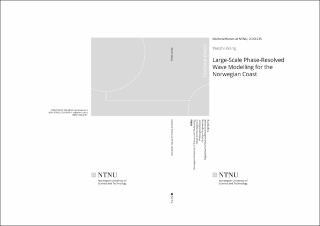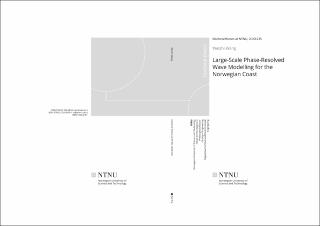| dc.contributor.advisor | Bihs, Hans | |
| dc.contributor.advisor | Arntsen, Øivind A. | |
| dc.contributor.author | Wang, Weizhi | |
| dc.date.accessioned | 2020-08-25T08:18:49Z | |
| dc.date.available | 2020-08-25T08:18:49Z | |
| dc.date.issued | 2020 | |
| dc.identifier.isbn | 978-82-326-4819-1 | |
| dc.identifier.issn | 1503-8181 | |
| dc.identifier.uri | https://hdl.handle.net/11250/2673803 | |
| dc.description.abstract | The coastal Highway Route E39 aims to build a continuous road connection along the west coast of Norway. Floating bridges are planned to replace the ferries at seven major fjords along the route. These innovative floating structures require comprehensive understanding of the wave fields in the fjords. Currently, the information on the wave fields can only be obtained from discrete field measurements. However, the measurements cannot represent the entire domain due to the limited number of wave gauges. Therefore, numerical wave modelling is needed in order to obtain an extensive understanding of the wave propagation and transformation in the entire domain of interest.
Phase-resolved wave models are able to represent most of the wave transformation phenomena and provide time domain information for further engineering analysis. However, the special coastal conditions in Norway limit the validity of many existing phase-resolved wave models. The deep water conditions and strong variation of the bathymetry created by the fjords go beyond the limits of many shallow water wave models. The irregular coastline challenges the grid generation and boundary treatments of many existing potential flow wave models. The large domain of interest in the fjords makes the usage of computational fluid dynamics (CFD) models impractical because of their high-demand of computational resources. Therefore, a new phase-resolved numerical wave model is required for an accurate and efficient simulation of large-scale wave propagation in the Norwegian fjords.
The first development for the new model is based on the improvement of depth-averaged shallow water modelling technique. A quadratic non-hydrostatic pressure profile is used to improve the ability of representing water waves in deeper water conditions. The numerical model is implemented in the open-source hydrodynamics framework REEF3D. The resulting wave model REEF3D::SFLOW inherits the highorder discretisation schemes and parallel computation algorithm from the framework. Comprehensive verification and validation of the model are performed through a The best performance of the model is found to be within a water depth to wavelength ratio up to 0.25. As a result, the model is not recommended for the wave modelling in the deepwater Norwegian fjords.
Further development of a fully nonlinear potential flow (FNPF) model is conducted. The resulting model REEF3D::FNPF solves the Laplace equation together with the boundary conditions on a σ-coordinate grid. The model also inherits the high-order discretisation schemes and parallel computation algorithm. In some simulations, the model is 800 times as fast as REEF3D::CFD for achieving the same accuracy. The model is also validated through a large variety of test cases. It is found that the accuracy of the model is not compromised by the water depth conditions, for example the free surface elevations during the de-shoaling process show a good agreement with the experimental measurements. The model is then used to investigate relevant phenomena regarding the floating bridges inside the fjords, including the evolution of rogue waves and the high-fidelity reproducing of three-hour irregular sea states with different severity of wave breaking.
In order to address the irregular coastline, a novel coastline algorithm is developed in REEF3D::FNPF. This algorithm provides a universal solution for the inclusion of coastlines and boundary treatments. The model is then used to simulate full-scale wave propagation in Mehamn harbour in northern Norway. The significant wave
heights Hs inside the harbour after the strong wave diffraction around the peninsulas and breakwaters show a good agreement with experimental measurements. This confirms the effectiveness of the coastline algorithm and the ability of the model of representing strong wave diffraction. Further studies of the wave fields in Sulafjord and Barørnafjord using REEF3D::FNPF provide insights on the wave frequency transition inside the fjords. A maximum simulation time to real time factor of 10 is also found for the large-scale simulations with tens of millions of cells.
The two new models REEF3D::SFLOW and REEF3D::FNPF are compared with the original CFD model REEF3D::CFD through several test cases to highlight the differences among them as well as their special features and area of applications. REEF3D::FNPF is an ideal model for large-scale wave propagation over varying bathymetry. REEF3D::SFLOW is a fast model for wave modelling in shallow to intermediate water depth and a model to study swash zone dynamics and sediment transport. REEF3D::CFD is the only model within the framework that is able to represent the overturning wave breaker and an ideal model to study local wave impacts and wave interaction with structures.
In conclusion, REEF3D::FNPF is suggested as the phase-resolving numerical model for the wave analysis in the fjords for the E39 project. The model is seen to be computationally efficient, phase-resolved, accurate and flexible. Developed as part of the open-source numerical framework REEF3D, the model is freely available to users. Future works of model coupling, inclusion of wind and current effects are also summarised in the end. | en_US |
| dc.language.iso | eng | en_US |
| dc.publisher | NTNU | en_US |
| dc.relation.ispartofseries | Doctoral theses at NTNU;2020:235 | |
| dc.relation.haspart | Paper 1: Wang, Weizhi; Martin, Tobias; Kamath, Arun; Bihs, Hans. An Improved Depth-Averaged Non-Hydrostatic Shallow Water Model with Quadratic Pressure Approximation. International Journal for Numerical Methods in Fluids 2020 ;Volum 92.(8) s. 803-824
https://doi.org/10.1002/fld.4807
This is an open access article under the terms of the Creative Commons Attribution License (CC BY 4.0) | en_US |
| dc.relation.haspart | Paper 2: Bihs, Hans; Wang, Weizhi; Pakozdi, Csaba; Kamath, Arun. REEF3D::FNPF – A Flexible Fully Nonlinear Potential Flow Solver. Journal of Offshore Mechanics and Arctic Engineering 2020 ;Volum 142.(4)
https://doi.org/10.1115/1.4045915 | en_US |
| dc.relation.haspart | Paper 3: Wang, Weizhi; Kamath, Arun; Pakozdi, Csaba; Bihs, Hans. Investigation of Focusing Wave Properties in a Numerical Wave Tank with a Fully Nonlinear Potential Flow Model. Journal of Marine Science and Engineering 2019 ;Volum 7.(10)
https://doi.org/10.3390/jmse7100375
This is an open access article under the terms of the Creative Commons Attribution License (CC BY 4.0) | en_US |
| dc.relation.haspart | Paper 4:
Wang W., P´akozdi C, Kamath A. and Bihs H.
A fully nonlinear potential flow wave modelling procedure for full-scale simulations of sea states with various wave breaking scenarios | en_US |
| dc.relation.haspart | Paper 5:
Wang W., P´akozdi C., Kamath A., Fouques S. and Bihs H.
A flexible fully nonlinear potential flow model for wave propagation over the complex topography of the Norwegian coast | en_US |
| dc.relation.haspart | Paper 6:
Wang W., P´akozdi C, Kamath A. and Bihs H.
Phase-resolved wave modelling in the Norwegian fjords for the ferry-free E39 project | en_US |
| dc.relation.haspart | Paper 7:
Wang, Weizhi; Kamath, Arun; Martin, Tobias; Pakozdi, Csaba; Bihs, Hans.
A comparison of different wave modelling techniques in an open-source hydrodynamic framework.
Journal of Marine Science and Engineering 2020, 8(7), 526;
https://doi.org/10.3390/jmse8070526
This is an open access article under the terms of the Creative Commons Attribution License (CC BY 4.0) | en_US |
| dc.title | Large-Scale Phase-Resolved Wave Modelling for the Norwegian Coast | en_US |
| dc.type | Doctoral thesis | en_US |
| dc.subject.nsi | VDP::Technology: 500::Environmental engineering: 610 | en_US |

